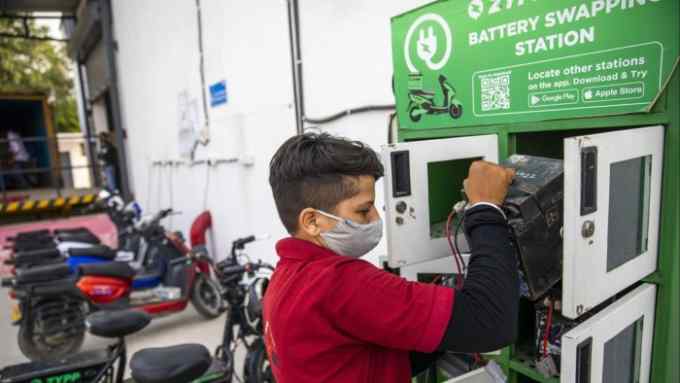FT ranking: High-Growth Companies Asia-Pacific 2024

Simply sign up to the Asia-Pacific companies myFT Digest -- delivered directly to your inbox.
This is the sixth annual ranking of 500 high-growth Asia-Pacific companies, compiled by the Financial Times and Statista, the data company.
Technology-related businesses represent nearly a third of the 2024 list, and our top-ranked company this year is Zypp Electric, an Indian electric-vehicle platform.
The ranking is based on revenue growth of companies between 2019 and 2022.
More details about the ranking, including the methodology, can be found below the table
While the Asia-Pacific region is still one of the world’s main growth engines, this year east Asia’s developing economies are set to expand at one of the lowest rates since the 1960s, according to the World Bank.
Last October, the bank warned that growth in the region’s developing economies would slow to 4.5 per cent in 2024, with depressed activity in China and lower productivity in other countries contributing to this gloomier outlook.
Companies that are interested in participating next year can register here.
Chinese companies are not included in our ranking due to difficulties in verifying data, but the country’s economic struggles are spilling into the wider region, as the government struggles with stimulus measures amid a property crisis, weak consumer demand, and low investor confidence.
Much of Asia is also starting to be adversely affected by new US industrial and trade policies under the Inflation Reduction Act and the Chips and Science Act.
A special report to accompany this ranking will be published in print and online on April 4, highlighting some of the fastest growing businesses and innovation hubs in the region.
India’s Zypp Electric tops this year’s list having achieved a 396 per cent compound annual growth rate (CAGR) from 2019 to 2022. Another Indian company takes second place: BigHaat, an agritech business, with a 304 per cent CAGR. It is followed in third spot by the Singapore-based logistics and transportation company ISO Tank Management, which has a 286 per cent CAGR.
The minimum CAGR needed to qualify for this year’s ranking was 15.1 per cent, down from 16.3 per cent last year. Growth percentages have been rounded to one decimal place for the table, above, but are ranked according to three decimal places.
Singapore is the city with the most fast-growing companies in this year’s ranking, with 93, just ahead of Seoul with 90 and Tokyo with 71.
But, in country terms, South Korea is home to the most growth companies in the list: 123 in total. Japan and Singapore are close behind with 101 and 93 companies, respectively. India is in fourth place with 71 companies making the cut.
The IT and software sector accounts for 30 per cent of companies in the ranking this year. The next most represented industry is fintech, financial services and insurance, which accounts for 8 per cent.
However, the ranking is not comprehensive as many fast-growing companies are privately held and do not make public any detailed financial information, while others do not wish to disclose their revenue figures, or choose not to take part for various reasons.
Of those that did share — and certify — their revenues, the 500 fastest-growing are listed in the table.
Methodology
High-Growth Companies Asia-Pacific 2024 is a list of 500 companies in the region that achieved the highest percentage growth in revenues between 2019 and 2022.
Application phase
The project was advertised online and in print, allowing all eligible companies to register via websites created by Statista and the Financial Times.
In addition, through research in company databases and other public sources, Statista identified tens of thousands of companies in Asia-Pacific as potential candidates for the ranking. These companies were invited to participate in the ranking by post and email.
The application phase ran from June to October 2023. The submitted revenue figures had to be certified by the company’s chief financial officer, chief executive, or a member of its executive committee.
Criteria for inclusion
To be included in the list of fast-growing companies in the Asia-Pacific region, a company had to meet the following criteria:
Revenue of at least $100,000 generated in 2019 (or currency value equivalent as of 2019);
Revenue of at least $1mn generated in 2022 (or currency value equivalent as of 2022);
Revenue growth between 2019 and 2022 that was primarily organic (ie, “internally” generated);
An independent company (not a subsidiary or branch office of any kind);
Headquartered in one of these 13 territories in the Asia-Pacific region: Australia, Hong Kong, India, Indonesia, Japan, Malaysia, New Zealand, Philippines, Singapore, South Korea, Taiwan, Thailand and Vietnam.
Calculation of growth rates
The calculation of growth rates is based on the revenue figures submitted by the companies in their respective national currencies. For better comparability in the ranking, the revenues were converted into US dollars.
The annual average exchange rates in 2019 and 2022, respectively, were used for this purpose. The compound annual growth rate (CAGR) was calculated as follows: (revenue2022 / revenue2019 )^(1/3)) — 1 = CAGR.
The absolute growth between 2019 and 2022 was calculated as follows: (revenue2022 / revenue2019) — 1 = Growth rate
Evaluation and quality assurance
All data reported by the companies was processed and checked by Statista. Missing data entries (employee numbers, address data, etc) were researched in detail. Companies that did not fulfil the criteria for inclusion in the ranking were deleted. The minimum average annual growth rate required to be included in the ranking this year was 15.12 per cent.
Disclaimer
The ranking was created through a complex procedure. Although the search was extensive, the ranking does not claim to be complete, as some companies did not want to make their revenue figures public or did not participate for other reasons.


Comments